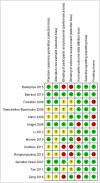Probiotics for Preventing Ventilator-Associated Pneumonia in Mechanically Ventilated Patients: A Meta-Analysis with Trial Sequential Analysis
- PMID: 29062279
- PMCID: PMC5640711
- DOI: 10.3389/fphar.2017.00717
Probiotics for Preventing Ventilator-Associated Pneumonia in Mechanically Ventilated Patients: A Meta-Analysis with Trial Sequential Analysis
Abstract
Background and Objective: Ventilator-associated pneumonia (VAP) is still an important cause of morbidity and mortality in mechanically ventilated patients. The efficacy of the probiotics for preventing VAP is still controversial. Present study was conducted to comprehensively evaluate the effect of probiotics on VAP prevention in mechanically ventilated patients. Methods: PubMed, Embase, and CENTRAL were searched up to September 2016. Eligible trials designed with randomized controlled trials (RCTs) comparing probiotics with control in mechanically ventilated patients were included. Risk ratios (RRs) and mean differences (MDs) with 95% confidence intervals (CIs) were estimated with fixed or random effects models. Trial sequential analysis (TSA) was performed using TSA 0.9beta software. Results: Thirteen RCTs (N = 1969) were included. Overall, probiotics were associated with reduced incidence of VAP (RR = 0.73, 95% CI = 0.60-0.89; P = 0.002), which was confirmed by TSA (TSA adjusted 95% CI = 0.55-0.96). However, no significant difference was observed in 90-day mortality (RR = 1.00, 95% CI = 0.72-1.37; P = 0.99), overall mortality (RR = 0.84, 95% CI = 0.70-1.02; P = 0.09), 28-day mortality (RR = 1.06, 95% CI = 0.72-1.57; P = 0.99), intensive care unit (ICU) mortality (RR = 0.97, 95% CI = 0.74-1.27; P = 0.82), hospital mortality (RR = 0.81, 95% CI = 0.65-1.02; P = 0.07), diarrhea (RR = 0.99, 95% CI = 0.83-1.19; P = 0.92), length of ICU stay (MD = -2.40 days, 95% CI = -6.75 to 1.95; P = 0.28), length of hospital stay (MD = -1.34 days, 95% CI = -6.21 to 3.54; P = 0.59), and duration of mechanical ventilation (MD = -3.32 days, 95% CI = -6.74 to 0.09; P = 0.06). Conclusions: In this meta-analysis, we found that probiotics could reduce the incidence of VAP in mechanically ventilated patients. It seems likely that probiotics provide clinical benefits for mechanically ventilated patients.
Keywords: meta-analysis; probiotics; randomized-controlled trial; trial sequential analysis; ventilator-associated pneumonia.
Figures















Similar articles
-
Clinical Benefits From Administering Probiotics to Mechanical Ventilated Patients in Intensive Care Unit: A PRISMA-Guided Meta-Analysis.Front Nutr. 2022 Jan 27;8:798827. doi: 10.3389/fnut.2021.798827. eCollection 2021. Front Nutr. 2022. PMID: 35155520 Free PMC article.
-
Probiotic in the prevention of ventilator-associated pneumonia in critically ill patients: evidence from meta-analysis and trial sequential analysis of randomized clinical trials.BMC Pulm Med. 2022 Apr 28;22(1):168. doi: 10.1186/s12890-022-01965-5. BMC Pulm Med. 2022. PMID: 35484547 Free PMC article.
-
Probiotic Supplementation Prevents the Development of Ventilator-Associated Pneumonia for Mechanically Ventilated ICU Patients: A Systematic Review and Network Meta-analysis of Randomized Controlled Trials.Front Nutr. 2022 Jul 8;9:919156. doi: 10.3389/fnut.2022.919156. eCollection 2022. Front Nutr. 2022. PMID: 35879981 Free PMC article.
-
Subglottic secretion suction for preventing ventilator-associated pneumonia: an updated meta-analysis and trial sequential analysis.Crit Care. 2016 Oct 28;20(1):353. doi: 10.1186/s13054-016-1527-7. Crit Care. 2016. PMID: 27788682 Free PMC article.
-
Can routine oral care with antiseptics prevent ventilator-associated pneumonia in patients receiving mechanical ventilation? An update meta-analysis from 17 randomized controlled trials.Int J Clin Exp Med. 2015 Feb 15;8(2):1645-57. eCollection 2015. Int J Clin Exp Med. 2015. PMID: 25932093 Free PMC article.
Cited by
-
Pathophysiology and protective approaches of gut injury in critical illness.Yeungnam Univ J Med. 2021 Jan;38(1):27-33. doi: 10.12701/yujm.2020.00703. Epub 2020 Sep 23. Yeungnam Univ J Med. 2021. PMID: 33022904 Free PMC article.
-
Clinical Benefits From Administering Probiotics to Mechanical Ventilated Patients in Intensive Care Unit: A PRISMA-Guided Meta-Analysis.Front Nutr. 2022 Jan 27;8:798827. doi: 10.3389/fnut.2021.798827. eCollection 2021. Front Nutr. 2022. PMID: 35155520 Free PMC article.
-
Synbiotics for prevention of ventilator-associated pneumonia: a probiotics strain-specific network meta-analysis.J Int Med Res. 2019 Nov;47(11):5349-5374. doi: 10.1177/0300060519876753. Epub 2019 Oct 3. J Int Med Res. 2019. PMID: 31578896 Free PMC article.
-
Mechanisms linking the human gut microbiome to prophylactic and treatment strategies for COVID-19.Br J Nutr. 2021 Jul 28;126(2):219-227. doi: 10.1017/S0007114520003980. Epub 2020 Oct 9. Br J Nutr. 2021. PMID: 33032673 Free PMC article. Review.
-
The Importance of the Microbiome in Critically Ill Patients: Role of Nutrition.Nutrients. 2019 Dec 7;11(12):3002. doi: 10.3390/nu11123002. Nutrients. 2019. PMID: 31817895 Free PMC article. Review.
References
-
- Banupriya B., Biswal N., Srinivasaraghavan R., Narayanan P., Mandal J. (2015). Probiotic prophylaxis to prevent ventilator associated pneumonia (VAP) in children on mechanical ventilation: an open-label randomized controlled trial. Intensive Care Med. 41, 677–685. 10.1007/s00134-015-3694-4 - DOI - PubMed
LinkOut - more resources
Full Text Sources
Other Literature Sources
Research Materials
Miscellaneous

